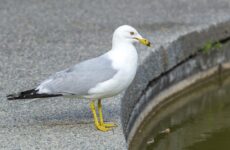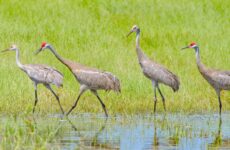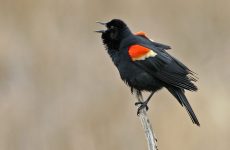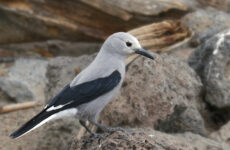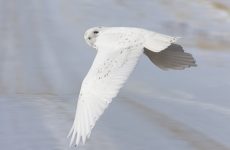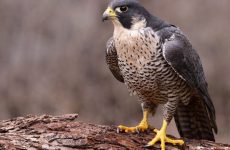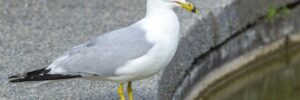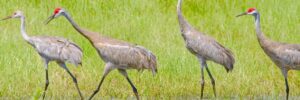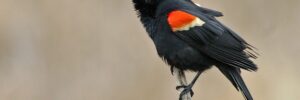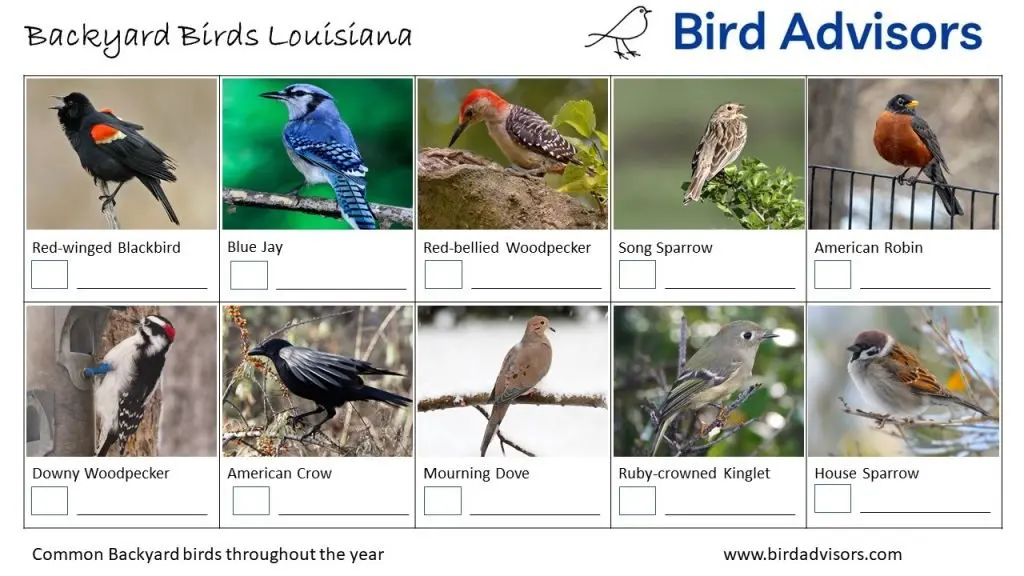
Do you need help with bird identification in Louisiana for birds that visit your backyard? Get ID information, pictures, and printable worksheets to help with these birds of Louisiana identification.
There is a great joy in putting up bird feeders and watching what comes to visit but it gets better if you know who they are and learn to identify birds in your backyard. Well, now you can find out what are the most common birds in Louisiana that visit feeders or hop across your lawn.
So if you’re ready to do some backyard birding then read on to find out how to identify birds in Louisiana and how to attract more birds to your yard.
Also, get free bird printables of backyard birds of Louisiana with pictures to help you with Louisiana bird identification and to keep track of the birds that visit your backyard.
Top 20 backyard birds in Louisiana
- Northern Cardinal
- Northern Mockingbird
- Mourning Dove
- Blue Jay
- Carolina Wren
- Yellow-rumped Warbler
- Carolina Chickadee
- Ruby-crowned Kinglet
- American Crow
- Red-bellied Woodpecker
- Red-winged Blackbird
- Eastern Phoebe
- House Sparrow
- American Goldfinch
- Barn Swallow
- White-throated Sparrow
- Downy Woodpecker
- European Starling
- Common Grackle
- Brown-headed Cowbird
These are the backyard birds most often seen in Louisiana that may visit your lawn or feeders. They are the birds that appear most frequently on state checklists on ebird and the data is a combination of birds most frequently spotted in Louisiana in summer (June and July) and winter (December and January).
Birds that are not often seen at feeders or in backyards were removed to give you the birds in Louisiana you are most likely to see from home.
This data mix ensures that whatever time of year you are bird-watching in Louisiana these are the birds you will most likely spot at feeders or on your lawn.
Free Printable Backyard Birds Worksheets for Louisiana
These free bird identification worksheets have all the common backyard birds in Louisiana at different times of the year. So when you want to do some backyard birding these handy guides have pictures and space to either tick off the types of birds you have seen or keep a tally of the total number of birds.

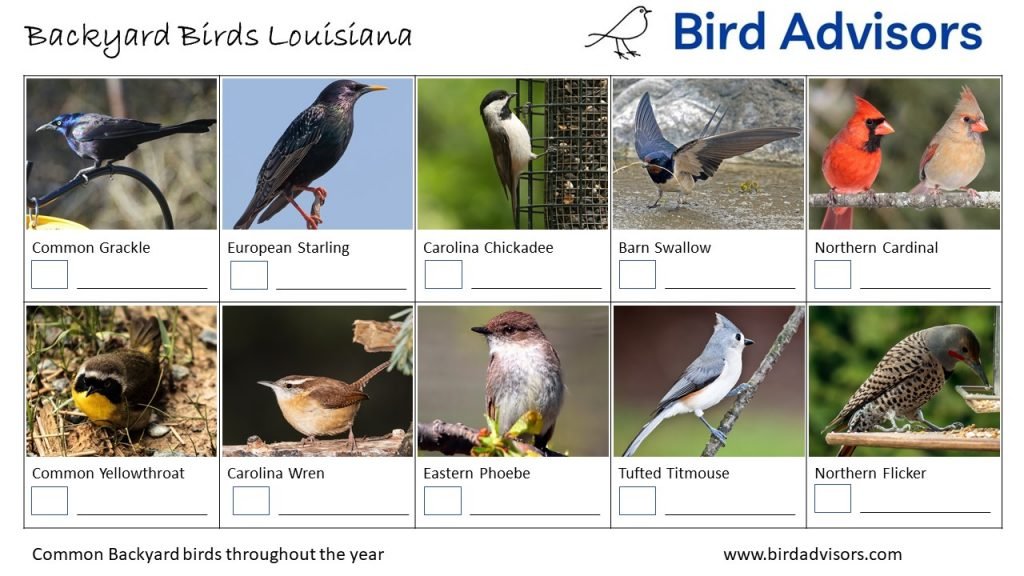
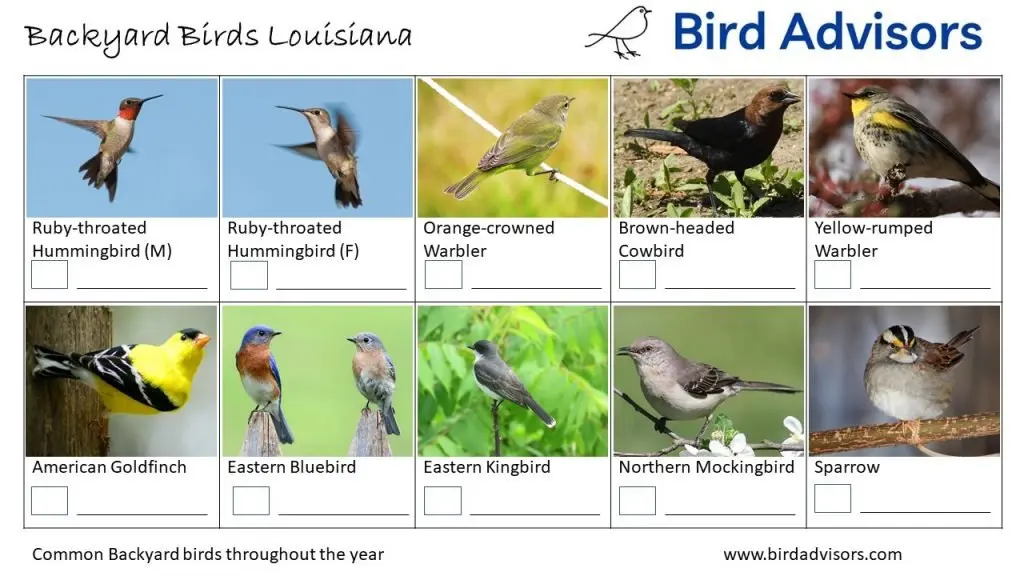
Top 20 backyard birds in Louisiana
1. Northern Cardinal
The bright red male Northern Cardinal with black around their faces is a great sight, especially against a white winter background. The females are also a little showy with their brown coloring, sharp brown crest, red highlights, and red beaks.
Northern Cardinals will sometimes attack their own reflection during breeding season as they obsessively defend their territories.
You can attract more Northern Cardinals to backyard feeders with sunflower seeds, peanut hearts, millet, and milo.
They will feed from large tube feeders, hoppers, platform feeders, or food scattered on the ground.
There are a surprising number of red birds in Louisiana that you can spot.
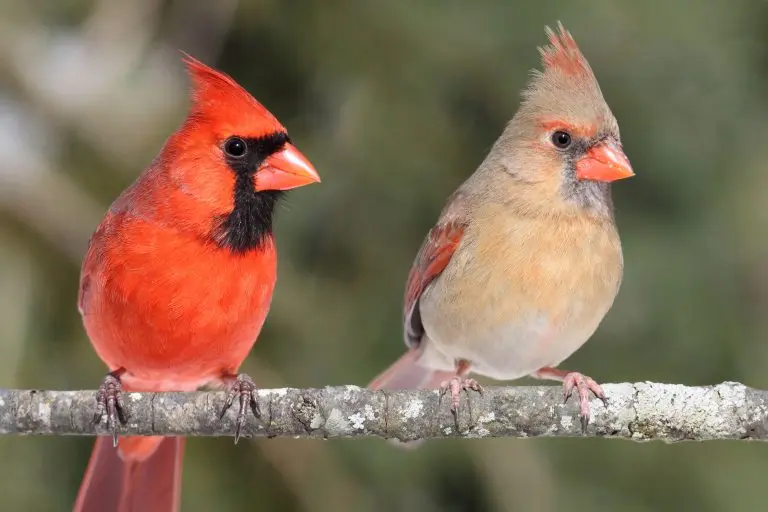
2. Northern Mockingbird
Northern Mockingbirds are medium-sized songbirds with small heads and long tails. They are a gray-brown color and slightly paler on the underside compared to the back. They have two white wingbars visible in flight.
They are usually seen alone or in pairs and aggressively defend their territory. A male mockingbird can learn around 200 songs in its life, copying other birds’ songs and they can sing all through the day and into the night.
They don’t often visit feeders but will come to open lawn areas. To attract more Northern Mockingbirds try planting fruiting trees or bushes, including hawthorns, mulberries, and blackberry brambles.
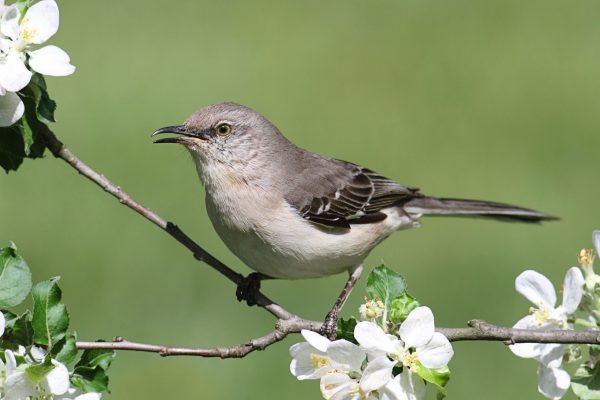
3. Mourning Dove
Mourning Doves are graceful small-headed birds, plump bodies and long tails. They are a soft brown with black spots on the wings.
They can be seen perching on telephone wires and forage for seeds on the ground.
You can attract more Mourning Doves to your backyard by scattering millet on the ground or on platform feeders. They will also eat black sunflower seeds, nyjer, cracked corn and peanut hearts.
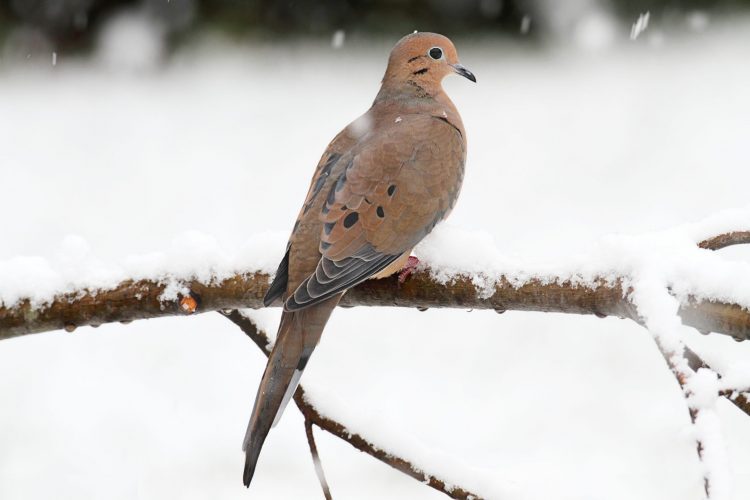
4. Blue Jay
Blue Jays are common songbirds with a blue upright crest, blue and black backs, and white undersides.
They are noisy birds that travel in family groups eating acorns when available. Mostly resident but may migrate from the far northwest of US.
They enjoy peanuts, sunflower seeds, and suet but prefer these on tray feeders or hopper feeders on a post. They will also enjoy a birdbath.
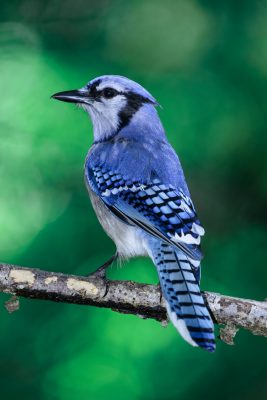
5. Carolina Wren
Carolina Wrens are shy birds that are dark brown on top and light brown underneath. They have a white eyebrow stripe and upright tail and loud teakettle song.
They can be found in woods or thickly vegetated areas and will visit backyard feeders.
You can attract more Carolina Wrens to your backyard feeders with suet feeders, hulled sunflower seeds or peanut hearts in large tube feeders or on platform feeders.
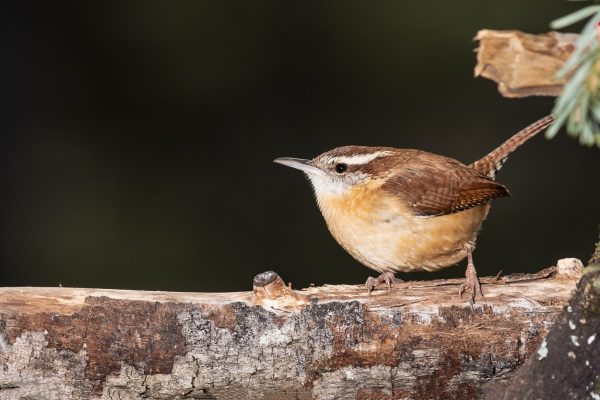
6. Yellow-rumped Warbler
Yellow-rumped Warblers are gray with flashes of yellow on the face, sides, and rump and white in the wings. Females may be slightly brown and winter birds are paler brown with bright yellow rumps and sides turning bright yellow and gray again in spring.
After breeding predominantly in Canada they migrate in large numbers south across most of southern and central North America and the Pacific Coast and throughout Mexico and Central America.
You can attract Yellow-rumped Warblers to your backyard with sunflower seeds, suet, raisins, and peanut butter.
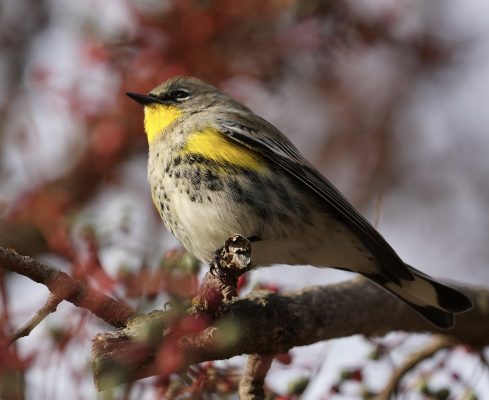
7. Carolina Chickadee
Carolina Chickadees are tiny birds with large heads, black cap and neck, white cheeks and belly, and soft gray back, wings, and tail.
They are visually very similar to the Black-capped Chickadee and they interbreed where their range overlaps.
They can be found in forested areas, parks, and backyards.
You can attract more Carolina Chickadees to your backyard feeders with Black oil sunflower seeds, Nyjer seeds, suet feeders, or peanuts. They will feed on most types of feeders including tube feeders, suet cages, or platform feeders.
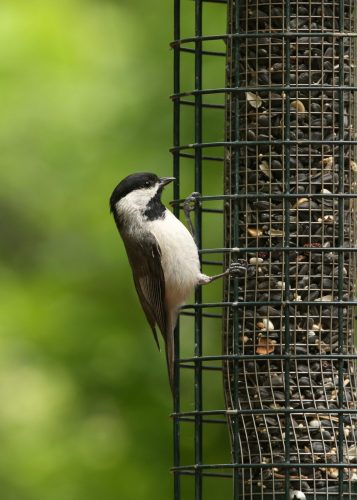
8. Ruby-crowned Kinglet
Ruby-crowned Kinglets are small songbirds that are olive-green and the males have a brilliant red crown that is usually flat so hard to see, but really great if you do.
They breed across Canada and the western mountains before migrating to southern and southwestern states and Mexico for the winter. They can also be seen during migration when they are widespread.
Ruby-crowned Kinglets can be hard to spot and they are fast-moving quiet birds that flit around in the foliage of lower branches and of shrubs and trees looking for spiders and insects.
They come to suet feeders or platform feeders for hulled sunflower seeds, peanut hearts, and mealworms.
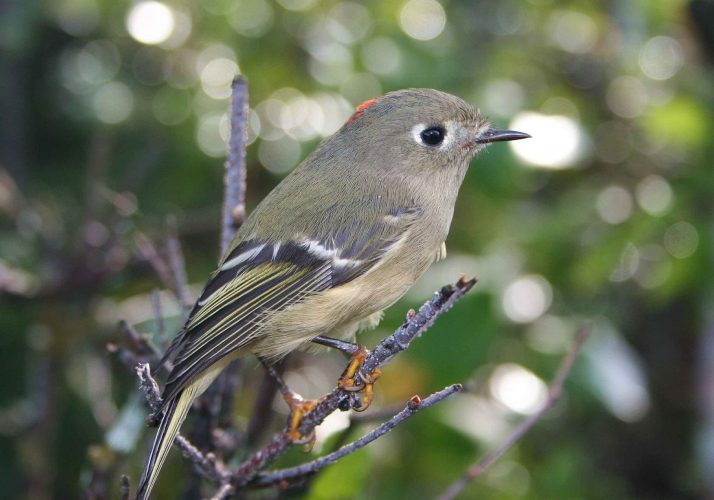
9. American Crow
American crows are large all-black birds that make a hoarse, cawing sound. They are common birds that can be found in most habitats including treetops, woods, fields, beaches, or towns.
They eat most things and usually feed on the ground eating earthworms, insects, seeds, and fruit.
You can attract more American Crows to your backyard by scattering peanuts.
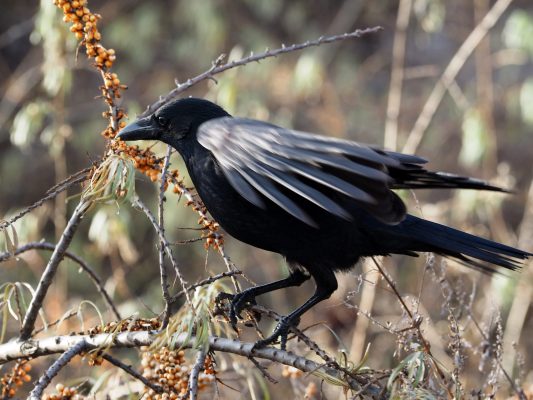
10. Red-bellied Woodpecker
Red-bellied Woodpeckers have a pale red belly that can be difficult to spot, with a red cap and nape and black-and-white stripped back.
They make a loud call in spring and summer and are found in woods and forests, especially with deadwood.
You can attract more Red-bellied Woodpeckers with suet feeders and they will sometimes feed from hummingbird feeders.
Check out all the woodpeckers in Louisiana that you can spot.
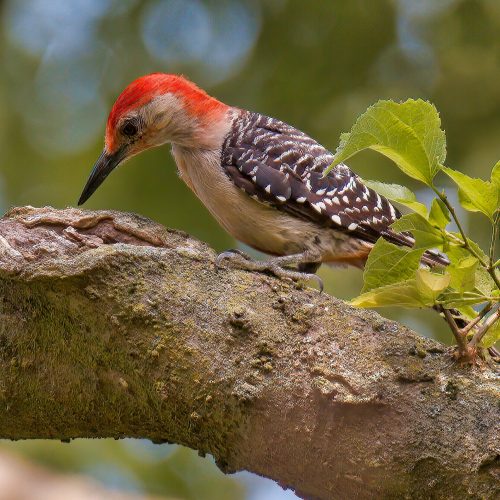
11. Red-winged Blackbird
Red-winged blackbirds are very common and easy to identify with the all-black coloring except for the bright red and yellow shoulder patches. The females are rather dull in comparison with brown streaky coloring.
They can often be spotted sitting on telephone wires and the males will fiercely defend their territories in the breeding season even attacking people that get too close to nests. In winter they roost in large numbers into the millions.
To attract more Red-winged blackbirds to your backyard try mixed grain and seeds spread on the ground. They will also feed on large tube feeders or platform feeders.
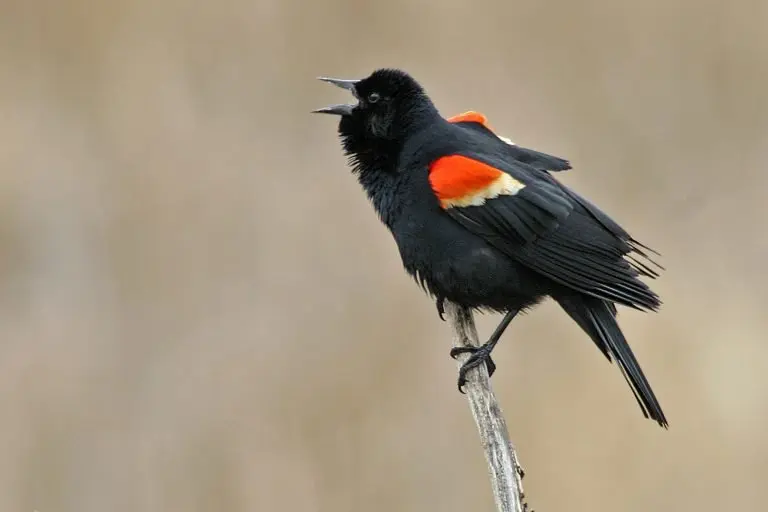
12. Eastern Phoebe
Eastern Phoebes are plump songbirds that are grayish-brown on the back and whitish underneath and with a darker head.
They are migratory birds, breeding across north-eastern states and into Canada before migrating to south-eastern states for winter.
They tend to be found alone, rather than in pairs or flocks, in quiet woodland wagging their tails from low perches. They often nest on bridges and barns or houses, making a nest out of mud and grass. They can be attracted to your backyard with a nest box.
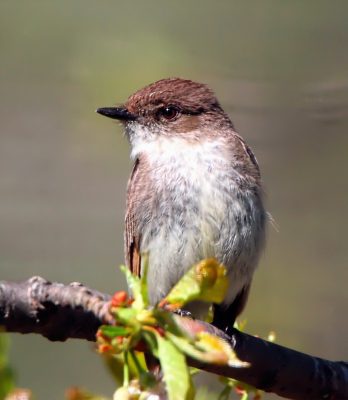
13. House Sparrow
The House Sparrow is another introduced species that has done very well and is now one of the most common birds. They are found near houses and buildings and can be quite tame so will eat out of your hand.
They can be considered a pest as they are non-native but will be found in backyards even if you do not feed them.
You can attract more House Sparrows to your backyard feeders with most kinds of birdseed, including millet, corn, and sunflower seeds.
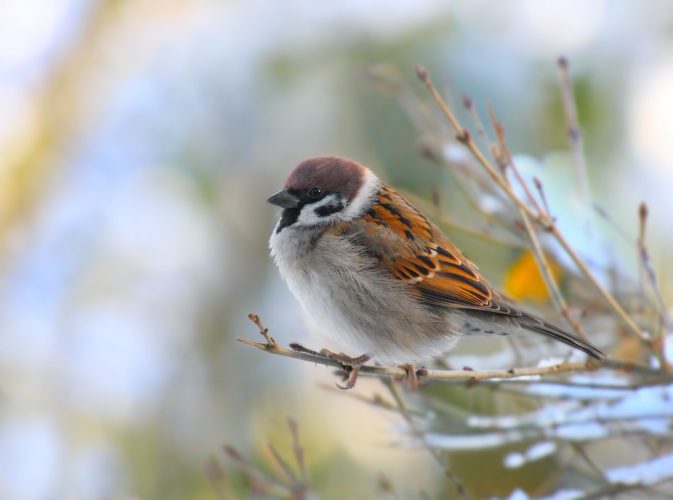
14. American Goldfinch
American Goldfinches are popular birds with the males bright yellow and black coloring in spring. The females are more dull brown as are males in winter.
They breed in Canada and northern two-thirds of the united states and resident year-round across central states and appear for winter in southern states.
To attract more American Goldfinches to your backyard try planting thistles and milkweed. They will visit most bird feeders and prefer sunflower seed and nyjer seed.
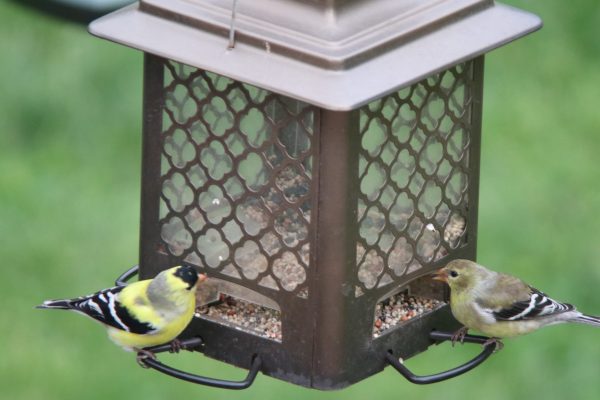
15. Barn Swallow
Barn Swallows are small birds with a deep-blue back, wings and tail, and reddish-brown underneath and across the face. The tail has long outer feathers that give a deep fork.
They breed over most of North America before heading to Central and South America. They can be found flying over meadows, farms, and fields looking for insects and usually build mud nests on man-made structures such as in barns.
You can attract more Barn Swallows by putting up nest boxes or cups and may eat ground-up eggshells on a platform feeder.
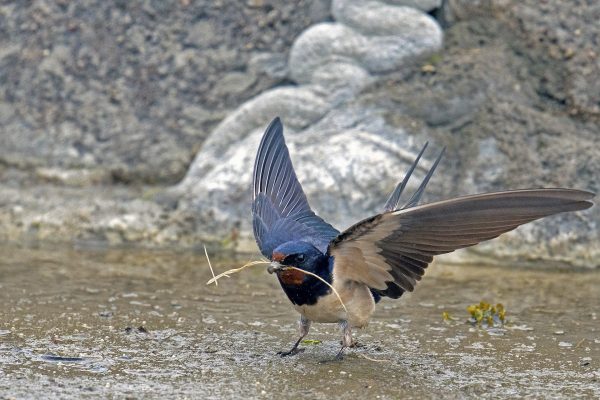
16. White-throated Sparrow
White-throated Sparrows have a distinctive black and white striped head, bright white throat, and yellow between the eye and bill. Their backs are brown and underneath is gray.
They are migratory birds, breeding mostly in Canada before heading south in winter to eastern and southern states and California. You can find White-throated Sparrows on the ground in woods and along the edges, often in large flocks.
You can attract White-throated Sparrows to your backyard feeders with millet and black oil sunflower seeds on platform feeders.
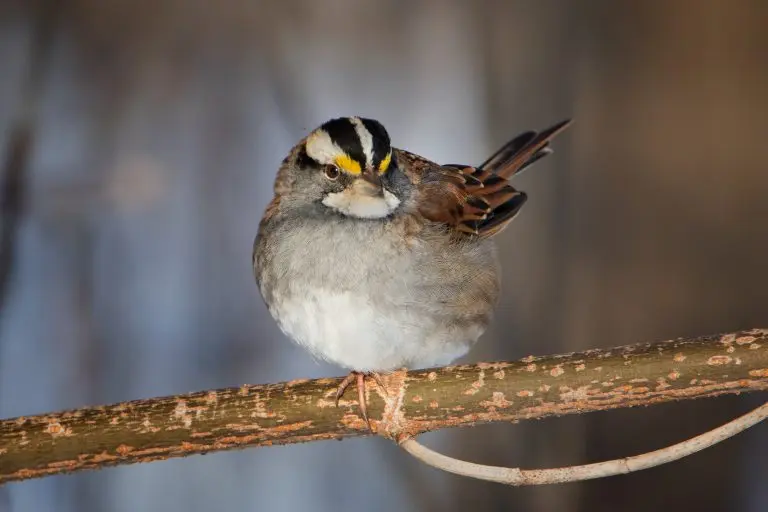
17. Downy Woodpecker
Downy Woodpeckers are small birds that are common at backyard feeders. They are often mixed in with other birds such as chickadees and nuthatches. They have black and white coloring with a red patch at the back of their heads. They look similar to the Hairy Woodpecker.
To attract more Downy Woodpeckers to your backyard try suet feeders but they will also eat black oil sunflower seeds, millet, and peanuts on platform feeders.
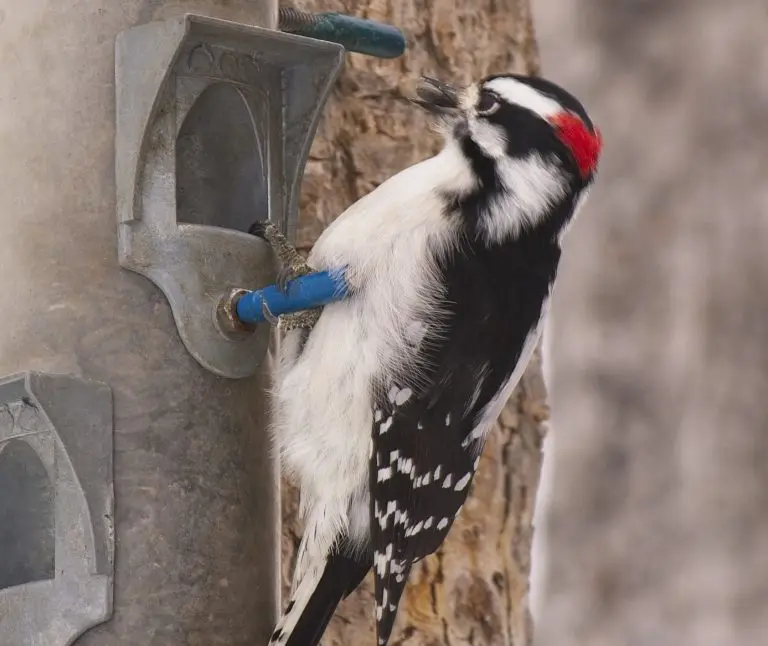
18. European Starling
European Starlings are not native but are now one of the most numerous songbirds. They are stocky black birds with iridescent purple, green, and blue tones.
Considered a pest by some due to their aggressive behavior these birds fly in large noisy flocks and can be seen perched in groups on the top of trees or flying over fields in flocks.
You can attract more European Starlings to your backyard feeders with black oil sunflower seeds, suet, cracked corn, and peanuts.
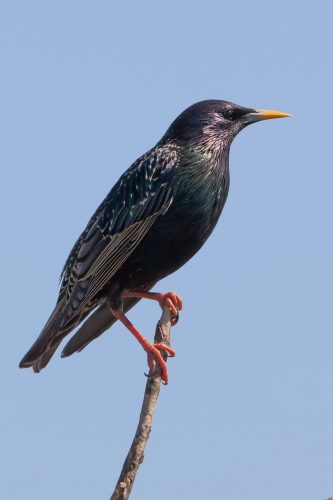
19. Common Grackle
The Common Grackle is a blackbird that is taller and longer tailed than a typical blackbird and with glossy iridescent bodies.
They eat many crops but mostly corn and gather in noisy groups high up in trees. Resident in most eastern states but migrates after breeding from the far northern US and Great Plains.
You can attract more Common Grackles to your backyard with most mixed grain and seed, sprinkled on the ground or on platform feeders.
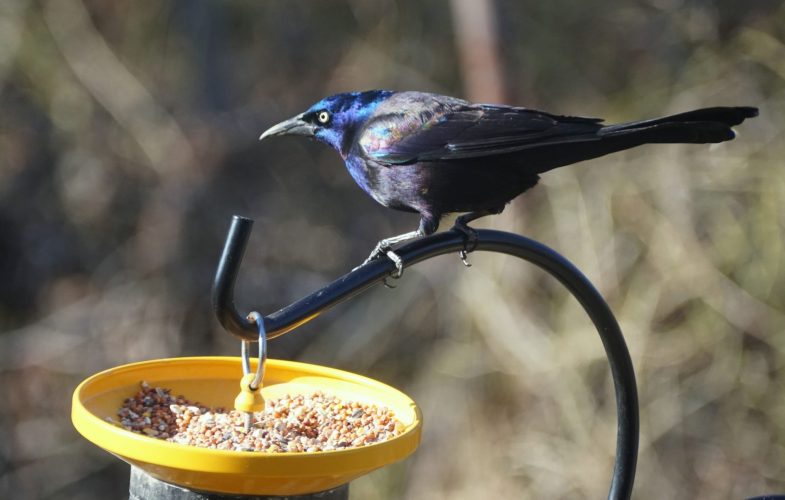
20. Brown-headed Cowbird
Brown-headed Cowbird males are black-bodied and brown-headed Blackbirds with short tails and thick heads. Females are brown all over with slight streaking.
They are often considered a nuisance as they destroy the eggs of smaller songbirds so that they can lay their eggs in the nest and have the bird foster their chicks.
They breed in much of the north and west of North America before heading further south but remain all year in the Eastern and Southern states and Pacific Coast.
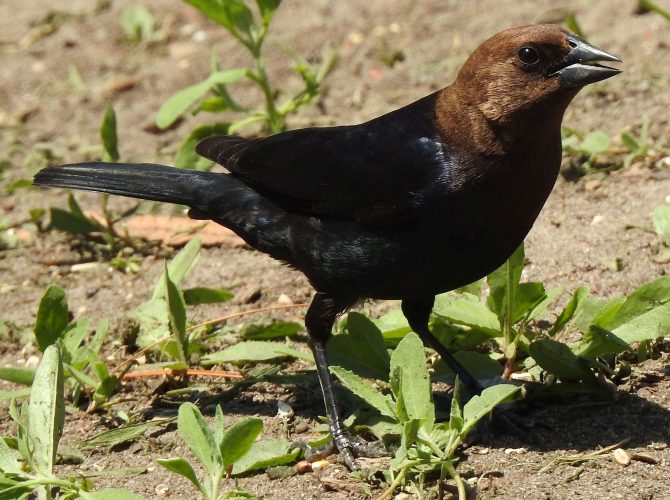
Best Bird Feeders to Attract Birds
A variety of different bird feeders will attract the most species of birds in Louisiana to your backyard
- Tube Feeders can be filled with different types of birdseed and depending on the seed different birds will be attracted. Black oil sunflower seeds attract Goldfinches, Chickadees, Woodpeckers, Nuthatches, and Pine Siskins.
- Ground Feeders or a tray below a Tube Feeder with Black oil sunflowers tube feeders attract Cardinals, Jays, Finches, and Sparrows.
- Platform feeders with Millet or Corn attract small and medium-sized birds such as sparrows, Blackbirds, Towhees, Juncos, Doves, Grackles, and Starlings.
- Peanut feeders attract Woodpeckers, Chickadees, Nuthatches, Titmice, Jays, Juncos, Finches, and Sparrows.
- Suet Feeders are great, especially in winter, for Woodpeckers, Cardinals, Nuthatches, Kinglets, Wrens, and Chickadees.
- Hummingbird feeders attract these tiny fascinating birds but they also attract other birds too.
How to Attract Birds to Your Backyard in Louisiana
If you would like to attract more birds to your yard in Louisiana there are some tips:
- Provide bird feeders for different types of birds to get the most species to visit your yard.
- Provide a water feature such as a birdbath fountain or stream. Ensure that the water is clean and not stagnant
- Grow native plants that will provide food and shelter. Plants, trees, and shrubs that provide fruit, berries, and nuts. Blackberries, wild grasses, elderberries, serviceberries, Oaks, Beeches, Cherries, sumacs, hemlocks, Purple Coneflowers, Sunflowers, Milkweed, Cardinal Flowers, Trumpet Honeysuckle, Virginia Creeper, Buttonbush, and Dogwoods.
- Let your grass grow long to provide cover and seeds.
- Leave a brush pile to provide food, protection, and nesting opportunities for birds.
- Don’t use pesticides and herbicides as these may be toxic to birds and prevent the natural foraging opportunities for insects and seeds that birds will seek in your yard.
- Set up nest boxes to attract breeding birds and ensure they are cleaned every year.
How to Identify Birds in Louisiana
Here are some more tips to help you identify birds in Louisiana, whether you chose to go out birding or stay home bird watching in Louisiana:
- Size – Size is the easiest thing to notice about a bird. Birds are often measured in inches or centimeters in guide books. It’s best to take a note of the bird in terms of small, medium, or large to be able to look for it later. A small bird is about the size of a sparrow, a medium bird is about the size of a pigeon and a large bird is the size of a goose.
- Shape – Take note of the silhouette of the bird and jot it down or draw the outline. Look at tail length, bill shape, wing shape, and overall body shape.
- Color pattern – Take a note of the main color of the head, back, belly, and wings, and tail for the main color and then any secondary colors or patterns. Also take note of any patterns such as banding, spots, or highlights.
- Behavior – Are they on the ground or high up in the trees. Are they in flocks or on their own? Can you spot what they are eating?
- Habitat – Woodlands, parks, shrubs, grasslands or meadows, shore or marsh.
- Use a bird identification app such as those created by ebird or Audubon

